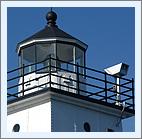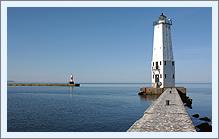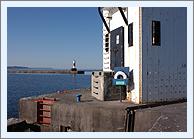 |
 |
 |
| Click thumbnails to view enlarged images | ||
| Frankfort North Breakwater Light | Seeing The Light |
|
|
|
|
Historical Information
With a violent nor’wester hard at his back in 1854, Buffalo captain George Tifft found his damaged schooner being inexorably driven toward the beach by the shallow opening into Lake Betsie. Calling on all his experience, Tifft managed to avoid certain destruction at the last minute by riding a wave across the shallow bar at the river mouth, and into the protection of Lake Betsie. Thus locked within the Lake, Tifft’s crew set about digging an opening in the bar through which to sail the schooner back into the lake. Marooned in the lake, Tifft took the opportunity to explore the area, finding it to be flush with natural resources and a perfect location for the establishment of a town and harbor. The crew finally managed to create an opening through the bar, and with favorable winds Tifft guided the schooner across the bar, and set sail for the Straits and thence home to Buffalo. Word spread of Tifft’s "discovery" of the bounty of Lake Betsie, and a number of "easterners began buying land around the lake. With harbor improvements key to the area’s growth, private interests undertook the first harbor improvement in 1859, spending $16,000 to dredge a channel between two short piers at the river mouth. With these initial improvements, Frankfort became the most northerly improved harbor on the eastern shore of Lake Michigan. With vessels making the Manitou Passage less than five miles offshore, the harbor soon became an ideal and frequently used harbor of refuge. Reflecting the harbor’s growing importance, Ohio Senator State Benjamin Franklin Wade presented a memorial praying for improvements to the harbor before the Senate on behalf of the Detroit Board of Trade and a number of Michigan ship owners on March 14, 1864. While the matter was referred to the Committee on Commerce for consideration, Wade continued to press the issue, presenting further memorials over the following month on behalf of maritime interests from Toledo to Milwaukee. Concurring with the growing importance of the harbor, Congress dispatched the Army Corps of Engineers to Frankfort to begin improvements on July 1, 1867. Plans for the new harbor called for the cutting of a new channel approximately seven hundred and fifty feet to the south of the natural outlet. This opening was then to be dredged to a width of two hundred feet and an overall depth of twelve feet. Protected by a pair of parallel piers and revetments, Lake Betsie would thus be opened-up to the largest vessels of the day. As harbor improvements progressed, Eleventh Lighthouse District Engineer General Orlando M Poe noted in his 1871 annual report that funding would be required in order to establish a pierhead beacon to guide mariners into the harbor on the project’s completion. With completion of the piers in 1873, plans for the new light station were well underway. John H King was appointed to the position of Acting Keeper of the Frankfort Pierhead Light on May 9 of that year. While a keeper’s dwelling was normally considered a vital component of such a new station, the appropriation requested for the establishment of the new Frankfort light station did not include sufficient funds to erect a keeper’s dwelling, and thus King was forced to rent accommodations in town.
With the Corps of Engineers returning to undertake continued improvements in the harbor, the South Pier was lengthened an additional 200 feet in 1884. While the work was underway, a violent storm swept through the area, and waves crashing across the pier destroyed 90 feet of the elevated walkway, and severely damaged an additional 170 feet. A crew was dispatched to Frankfort to effect the necessary repairs, and while at the site, they also erected a wood-framed oil storage shed and boat hoist at the inner end of the pier to allow the keeper to hoist his boat onto the pier deck. Before the end of the season, the beacon was lifted and moved 195 feet along the pier to the new pierhead. That winter, the schooner AMSDEN was entering the harbor under tow when she parted her tow line, and ran her bowsprit through 32 feet of the elevated walk. Keeper Albert Vorce hired a local work crew, and personally directed the necessary repairs.
After experiencing frequent problems with the old fog apparatus, the fog signal machinery from Chicago, which was being replaced by a steam operated fog signal plant, was shipped to the depot in St. Joseph for refurbishment in 1898, and installed at Frankfort the following year. However, after continuing problems were experienced with the replacement mechanism, the decision was made to install an air operated siren at the station in 1900. To this end, a 2-horsepower diesel engine was installed in the enclosed lower section of bell tower alongside the fog bell apparatus and connected to a siren and copper trumpet which were installed on the exterior of the building. Installation of the new fog signal apparatus was completed on May 1, 1901. By the end of July, foggy weather conditions caused the new signal to be activated for a total of 54 hours, during which it proved itself to be a vast improvement over the old system.
Evidently, the funds for erecting a keeper’s dwelling were finally approved, as 1907 saw the commencement of condemnation proceedings on a parcel of land selected for the new dwelling. To this point, we have been unable to identify definitively whether the much needed dwelling was ever built. However, the 1910 annual report of the Lighthouse Bureau reports that bids were solicited for the erection of a brick oil storage building at the station. Since such a brick structure would necessarily have to be built on land, it is likely that it was built on the same land on which a dwelling was finally erected.
The lens lantern from the South Pier rear range light was moved to a 66-foot tall wooden post erected 200 yards behind the new light on the north pier. The old South Pierhead Light and fog signal were then both demolished, and replaced with an acetylene powered lens lantern on a 35-foot tall open-framed pyramid structure 15 yards from the end of the south pier.
Declining railroad business in the 1960's and 1970's sounded the
death toll for the car ferry fleet. The last of the ferries working out
of Frankfort was sold and towed out of Frankfort Harbor in 1967, where
she had been laid up in Lake Betsie for a number of years. Today,
Frankfort harbor sits quiet and empty, save for a fleet of pleasure
boats that head in and out of the lake on summer weekends. Keepers of this Light Click Here to see a complete listing of all Frankfort North Breakwater Light keepers compiled by Phyllis L. Tag of Great Lakes Lighthouse Research. Seeing this Light Frankfort harbor was very quiet when we visited. Other than one man fishing on the end of the pier in the shadow of the lighthouse, we had the place completely to our ourselves. Like a number of lighthouses on the Eastern shore of Lake Michigan, the Frankfort pier light guards the point at which a man-made channel has been created between a landlocked lake and Lake Michigan itself. Thus, most of the town of Frankfort has grown up around the safe harbor provided by Betsie Lake, and the Lake Michigan shoreline around the lighthouse has stayed fairly clear. Pristine sand beaches stretch North and South as far as the eye can see, and stately Victorian era summer homes are lined-up immediately behind the beach. The town has done a wonderful job of installing wooden trails along the beaches, one of which leads down to the pier itself. We had an enjoyable hour wandering the boardwalk trails, and looking at the beautiful old houses. As we walked out to take a close look at the North
Breakwater Light, we noticed a door on the second deck of the new base
on which the tower was erected in 1932. It seems likely that there were
plans to install a catwalk leading to this door. However, such a catwalk
was never built, and the "door to nowhere" stands ten feet
above the surface of the pier with a steel protective railing around it.
|